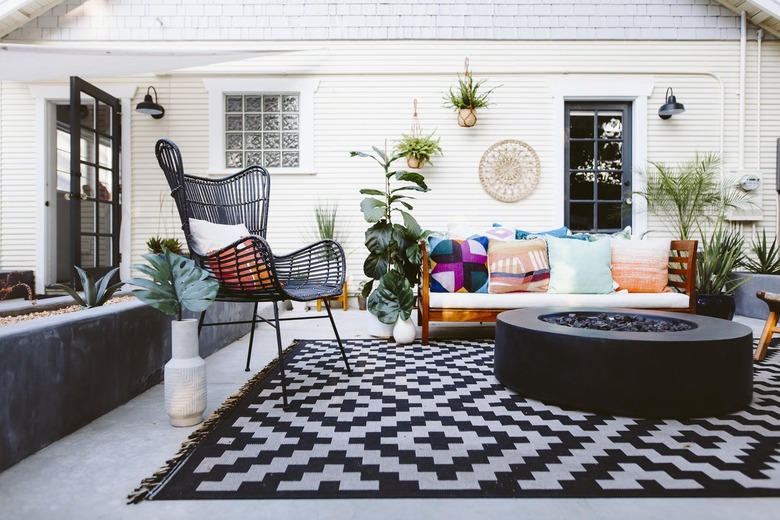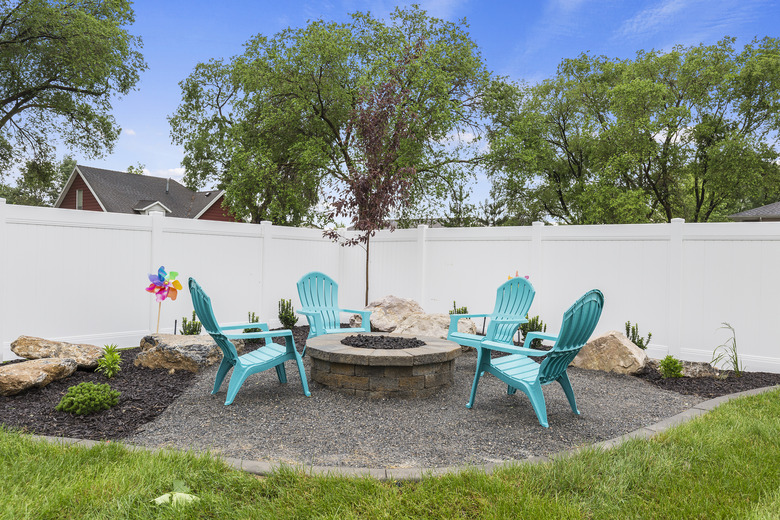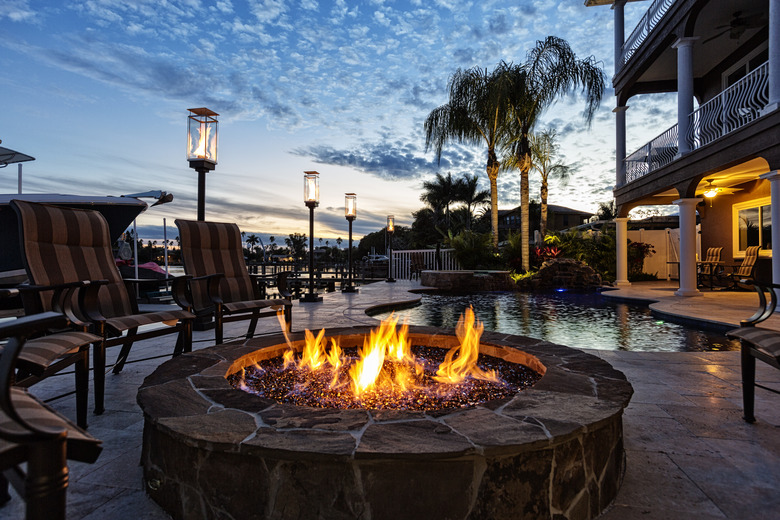Fire Pit Safety Tips And Requirements
We may receive a commission on purchases made from links.
A fire pit can make a charming and cozy addition to your backyard, but it's important to understand fire pit safety to keep those gathered around the fire away from harm. In addition to following fire pit safety tips, you may find your fire pit regulated by local ordinances and zoning laws. Basic burning rules and safety guidelines apply to all types of fire pits, but if you're planning to build a permanent pit, you'll need to know about restrictions and requirements before starting construction so you know where you can legally and safely build.
Know the Rules
Know the Rules
Fire pit safety is important — so important that many local zoning boards and homeowners' associations often have strict rules about them. Always check these rules before you even set up your fire pit, let alone strike a match.
Typically, it's recommended that you keep your fire 20 to 30 feet away from your home, outbuildings, fences and anything flammable. In areas with small lots where this isn't feasible, you'll need to keep your fire pit at least 10 feet away from these structures.
Ordinances may also dictate what size fires you can build and what materials you can use to create a fire pit. If you're installing a permanent gas fire pit, you may need construction permits and inspections. Additional rules may also apply. In Chicago, for example, you must cover your outdoor fire pit with some type of lid, and you cannot burn anything other than wood.
Remember to check your homeowners' insurance policy as well as local regulations. Some insurance companies require you to disclose the addition of a fire pit to your home.
Choose the Best Location
Choose the Best Location
Distance from your home and outbuildings isn't the only thing for which you'll need to look out when choosing a location for your backyard fire pit. You'll also want to make sure overhanging branches are well above the pit to avoid a fire hazard.
Ideally, you should place your fire pit on a nonflammable surface, such as a concrete pad, gravel, pavers or brick. When placing the pit on a patio, make sure there isn't a pergola or other structure above you. If you don't have a fireproof surface to help ensure fire pit safety, a bare and level patch of soil is the next best thing.
Never set your fire pit on a wood deck or grass. When you do have to place it on the ground, rake the area well and make sure it's clear of grass, plants and fallen leaves. Clear the ground in a 5-foot radius around your fire pit.
Constructing a Safe Fire Pit
Constructing a Safe Fire Pit
If desired, you can build your own fire pit. Many hardware stores sell fire pit kits that include a metal ring that forms the fireproof sides of the pit. You can then use the included stones or pavers to wrap your fire ring in a decorative finish.
You may also opt to build a fire pit with stones of your choosing and a separately purchased fire pit bowl rather than purchasing a kit. If you do, be very careful when choosing stones to place around your fire pit, as some can explode if they get too hot. Shale, for example, will explode when heated and spreads dangerous shrapnel when it does. Make sure you know what type of stone you're using and verify that it's safe. If you prefer, you can simply purchase a portable metal fire pit. These kits are readily available at hardware stores, are easy to assemble and are made of metals that can withstand the heat of a fire. Most also come with a spark screen that fits over the top of the pit and helps keep your fire contained.
Pick Your Fire Pit Fuel
Pick Your Fire Pit Fuel
Nothing has the same smell or feel as an authentic wood-burning fire. If you want the whole experience of listening to a fire crackle while enjoying the distinct aroma of wood smoke, you may feel that there is simply no substitute. Wood fire pits are also the cheapest to install and operate, making them great for tight budgets.
However, wood smoke can burn your eyes, may irritate asthma and can travel to the neighbor's yard. Wood is a renewable resource, but it doesn't burn cleanly and can be deceptive to extinguish. If you don't extinguish a wood fire completely, your fire could start again when you're not around and cause a safety concern.
If you prefer an easy fire that gives you the ultimate control, consider a gas or propane fire pit. Both of these options allow you to adjust the size of your flames and produce little to no smoke when in use. When you're done enjoying these fire pits, you can turn off the fuel completely and know that your fire is truly and safely extinguished. You won't have to worry about cleaning up potentially hot ash or embers either.
If you're amenable to a permanent installment, consider a gas fire pit. These fire pits are permanent and require a natural gas line, so they're a bit more expensive to install. Installation may also require a building permit and a professional since gas lines are involved.
If you like the idea of a gas fire pit but don't want to sacrifice portability, then opt for propane. Note, however, that you may pay for this convenience. Propane can get costly if you use your fire pit often. The same may be true of gas since the market price fluctuates.
To Burn or Not to Burn
To Burn or Not to Burn
When it's time to light your fire, you'll need to decide if you should burn and what you should burn. First, you'll need to pay attention to local weather and restrictions.
During periods of drought and extremely dry weather, some places institute temporary burn bans that prohibit fires at certain times. Some areas also ban burning on days when the air quality is poor due to pollution. Make sure you're not under such a ban before starting a fire.
You'll also need to check the weather forecast. Fires get out of control quickly on windy days, so wait for a calm night to light your fire. If the breeze is mild and you deem it safe to light your fire, always verify that there is nothing flammable downwind just in case.
Once you decide whether to burn, decide what to burn. This is easy since you should only burn dry, seasoned firewood. Wood that is too green will smoke excessively, and it's best to avoid burning it. Doing so isn't necessarily unsafe as long as you don't have asthma, but it can sting your eyes and smoke out your neighbors if they're trying to enjoy their yard or patio while you're burning.
It's important that you don't burn pressure-treated lumber or wood that's been stained or painted. These types of wood may contain toxic chemicals that you don't want to inhale around the fire. Avoid burning trash as well. Refrain from burning leaves and paper since both tend to flutter when the wind kicks up and can easily float out of the safe confines of your fire at the slightest breeze.
General Fire Pit Safety Tips
General Fire Pit Safety Tips
Before you even think about starting a fire, make sure you have your garden hose, a water bucket or a fire extinguisher nearby. It's also a good idea to have a fire blanket that you can use to smother flames on the ground or wrap around a person if clothing should catch fire.
Also remember the old adage "ask and ye shall receive." In this case, using gas, lighter fluid or other accelerants to start a fire is asking for trouble that you don't want to receive. Stick to matches and maybe a fire-starter stick if you need it to get things going. Wax fire starters also work well.
When adding seating around the fire pit, make sure you keep the chairs a safe distance from the fire. If necessary, use longer marshmallow or hot dog sticks rather than moving in closer to the fire. Avoid wearing loose clothing around the fire and always keep your kids and pets at least 3 feet away from the flames.
Although you don't want to ruin the ambiance around your fire pit, it's a good idea to add some lighting to the area. A few simple solar lights will do the trick without overpowering the mood. Lights will help prevent tripping in the dark.
Never leave a fire unattended and make sure all of the embers are cold before walking away from a fire for the night. Use a poker or metal shovel to thoroughly spread the embers around and make sure there aren't hot ones hiding under cold ones. If you have a gas fire pit, always remember to turn off the gas when you're done using the pit.
References
- The Allstate Blog: What to Know When Considering a Backyard Fire Pit
- HomeAdvisor: Home Fire Pit Safety Precautions
- Mother Earth News: 5 Fire Pit Safety Tips From A Former Wildland Firefighter
- Consumer Reports: Safety Rules: CR's Guide to Fire Pits
- Outland Living: Can I Have a Fire Pit in my Backyard? Laws, Restrictions by State
- Creative Energy: 7 Outdoor Gas Firepit Safety Tips
- The Home Depot: How to Build a Fire Pit
- Lowe's: How to Build a Fire Pit Ring


